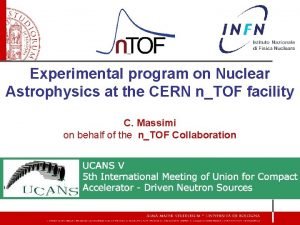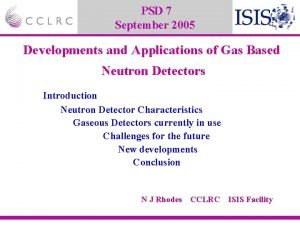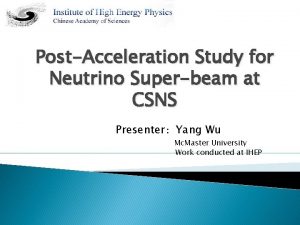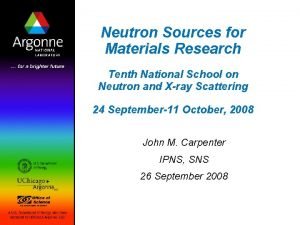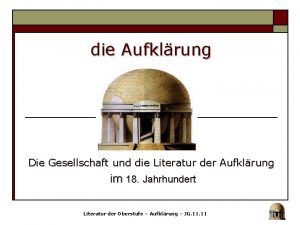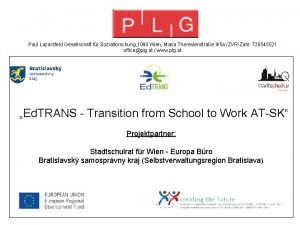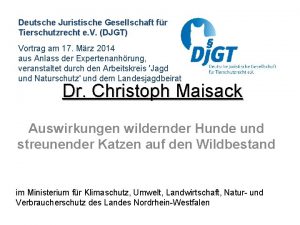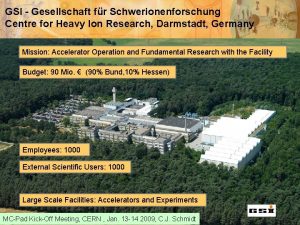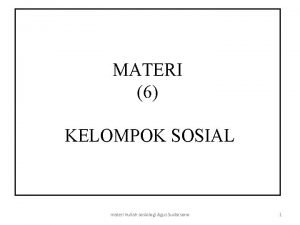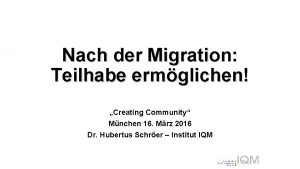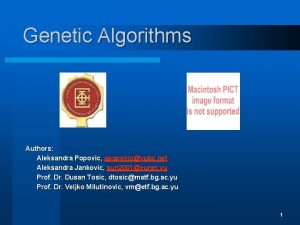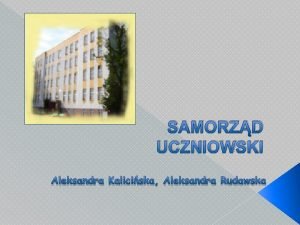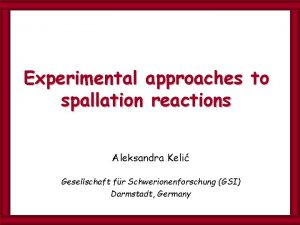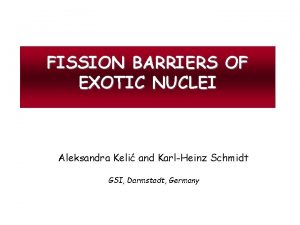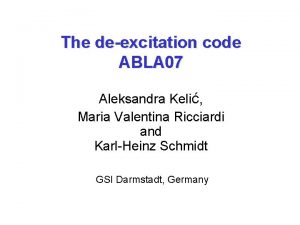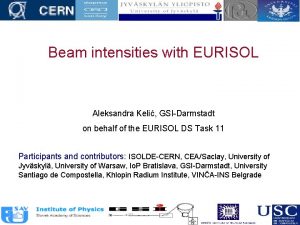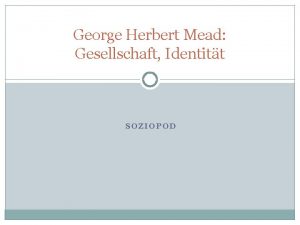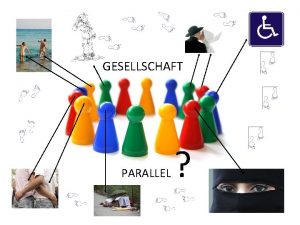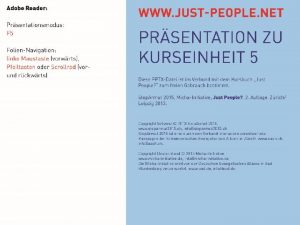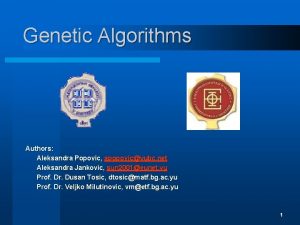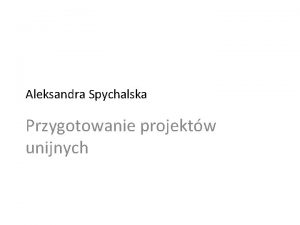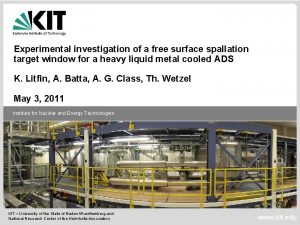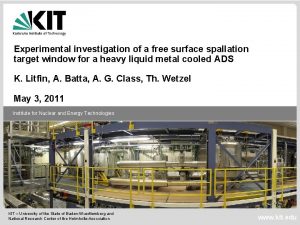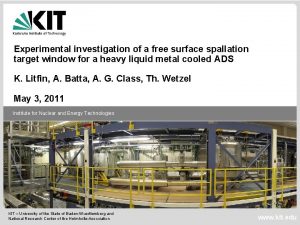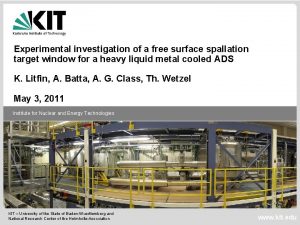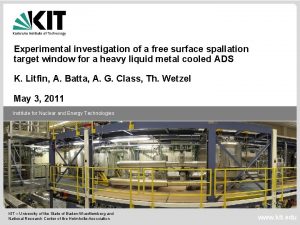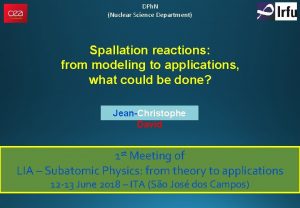Experimental approaches to spallation reactions Aleksandra Keli Gesellschaft























![Experimental progress by inverse kinematics Projectile Target Energy [A Ge. V] 56 Fe 1 Experimental progress by inverse kinematics Projectile Target Energy [A Ge. V] 56 Fe 1](https://slidetodoc.com/presentation_image/900dec21a1ecc8da5a036895b8d0f230/image-24.jpg)






- Slides: 30

Experimental approaches to spallation reactions Aleksandra Kelić Gesellschaft für Schwerionenforschung (GSI) Darmstadt, Germany

Outline - Introduction Why studying spallation reactions Experimental challenges - Experimental approaches Direct kinematics Inverse kinematics For neutrons and light charged particles see e. g. : Herbach et al, Nucl. Instr. Meth. A 503 (2003) 315; Borne et al, Nucl. Instr. Meth. A 385 (1997) 339; Trebukhovsky et al, Phys. Atom. Nucl. 68 (2005) 3 - Next generation experiments - Conclusions

Definition Wikipedia (http: //en. wikipedia. org): 'In nuclear physics, it is the process in which a heavy nucleus emits a large number of nucleons as a result of being hit by a high -energy proton, thus greatly reducing its atomic weight' First observations: Shopper et al, Naturw. 25 (1937) 557 – interaction of cosmic rays in a track detector Seaborg, Ph. D thesis 1937 - inelastic scattering of neutrons The concept of nuclear spallation was first coined by Glenn T. Seaborg: 'In order to distinguish these reactions from the ordinary nuclear reactions in which only one or two particles are ejected, in 1947 I coined the term “spallation” reactions. This term has since become standard in the field'.

Interest in spallation reactions Basic research See talks by: K. -H. Schmidt, P. Napolitani, A. Botvina Applications - Astrophysics (Reedy et al. , J. Geophys. Res. 77 (1972) 537) - Transmutation of nuclear waste (Bowmann et al, Nucl. Instr. Meth. A 320 (1992) 326; Rubbia et al, Report CERN/AT/95 -44/(ET), 1995) - Space technologies (Buchner et al, IEEE Trans. Nucl. Sci. 47 (2000) 705 Tang et al, Mat. Res. Soc. Bull. 28 (2003)) - Biology and medicine (Wambersie et al, Radiat. Prot. Dosim 31 (1990) 421; Bartlett et al, Radiat. Res. Cong. Proc. 2 (2000) 719) - Radioactive-beam production (EURISOL project) - Spallation-neutron sources (SNS, ESS) Facilities SATURNE (F), IPNO (F), COSY (D), GSI (D), PSI (CH), ITEP (RU), JINR (RU), LANL (USA), BEVATRON (USA), KEK (J)

Experimental challenge

Experimental challenge Low-energy reactions (~ Me. V) Decay Proton / neutron Target Compound nucleus High-energy reactions (~ Ge. V) Decays Proton / neutron Target Ensemble of compound nuclei

Experimental challenge Data measured at GSI* * Ricciardi et al, Phys. Rev. C 73 (2006) 014607; Bernas et al. , Nucl. Phys. A 765 (2006) 197; Armbruster et al. , Phys. Rev. Lett. 93 (2004) 212701; Taïeb et al. , Nucl. Phys. A 724 (2003) 413; Bernas et al. , Nucl. Phys. A 725 (2003) 213 www. gsi. de/charms/data. htm More than 1000 different nuclides produced in the spallation reaction. Need for identifying all nuclides – from the lightest to the heaviest products.

Experimental challenge Short-lived as well as stable nuclei have to be detected.

Experimental approaches

Experimental approaches Direct kinematics - Chemistry - -spectroscopy Proton beam - Accelerator-mass spectrometry at 1 Ge. V Heavy-ion target Advantages: Problems: - Excitation functions readily measured - Short-lived nuclei - Separation between isomer - Limitations on target materials and ground-state production - Very few independent yields - No information on kinematical properties

Experimental approaches Inverse kinematics Heavy-ion beam at 1 A Ge. V Hydrogen target Advantages: - "All" half-lives - All nuclides - Kinematical properties Magnetic spectrometer Reaction products Problems: - Excitation functions cannot be measured in one experiment - No separation between isomer and ground-state production

Experimental approaches - Direct kinematics -

Experimental setup Irradiated samples studied by -decay spectroscopy or in case of stable and long-lived nuclei by AMS.

Nuclide identification -ray spectra measured in p (1 Ge. V) + 208 Pb by Titarenko et al, Phys. Rev. C 65 (2002) 064610 To obtain cross sections one also needs: - gamma transitions - half lives - branching ratios

Excitation functions Independent and cumulative yields - About 100 (mostly cumulative) yields/system - Uncertainty 7 – 30 % Additional information: - Miah et al, Nucl. Sc. Tech. Suppl. 2 (2002) 369 - Schiekel et al, Nucl. Instr. Meth. B 114 (1996) 91 - Adilbish et al, Radiochem. Radioanal. Lett. 45 (1980) 227 - Chu et al, Phys. Rev. C 15 (1977) 352 Titarenko et al, 2005

Experimental approaches - Inverse kinematics -

GSI facility § UNILAC : Up to 20 A Me. V § SIS : 50 – 2000 A Me. V, up to 1011 part/spill

Experimental setup To. F x 1, x 2 B E Z max = 15 mrad p/p = 1. 5 % Resolution: - ( )/ 5· 10 -4 - Z 0. 4 - A / A 2. 5 10 -3

Nuclide identification 238 U + 1 H at 1 A Ge. V Ricciardi et al, Phys. Rev. C 73 (2006) 014607

Limited momentum acceptance 31 P Overlap of measurements with different magnetic-filed settings.

Velocity distributions 238 U (1 AGe. V) + 2 H Pereira, Ph. D thesis N O I T S S FI N O I A T N E M G A R F Limited angular acceptance of FRS together with different kinematical properties of fission and fragmentation residues reaction mechanism For each nucleus: production cross section, velocity and production mechanism

www. gsi. de/charms/data. htm Napolitani Ph. D, Villagrasa Ph. D Napolitani Ph. D Enqvist et al, Kelić et al Taieb et al, Bernas et al, Ricciardi et al An overview of measured data

Experimental progress by inverse kinematics Example: Fission of lead induced by ≈ 500 Me. V protons Protons (553 Me. V) on lead 208 Pb (500 A Me. V) on hydrogen
![Experimental progress by inverse kinematics Projectile Target Energy A Ge V 56 Fe 1 Experimental progress by inverse kinematics Projectile Target Energy [A Ge. V] 56 Fe 1](https://slidetodoc.com/presentation_image/900dec21a1ecc8da5a036895b8d0f230/image-24.jpg)
Experimental progress by inverse kinematics Projectile Target Energy [A Ge. V] 56 Fe 1 H, 2 H 0. 2 - 1. 5 136, 124 Xe 1, 2 H, Be, Ti, Pb 197 Au 1 H 208 Pb 1, 2 H, 238 U 1, 2 H, 0. 2, 0. 5, 1 0. 8 Ti 0. 5, 1 Ti, Pb 1 More than 1000 nuclei/system measured Data accuracy: Statistic: below 3% Systematic: 9 - 15 % Data available at: www. gsi. de/charms/data. htm

Measured cross sections Model calculations 238 U Experimental data: (1 A Ge. V) + 1 H Model calculations (model developed at GSI):

Next generation experiments

Future - Full identification of heavy residues with simultaneous measurement of neutrons, light charged particles and gammas Aiming for a kinematically complete experiment. -Increased beam energies and intensities -Spectrometers with larger acceptance and/or better resolution

R 3 B @ FAIR Protons Exotic beam from Super-FRS g-rays Neutrons Protons Heavy fragments Neutrons Target Tracking detectors: DE, x, y, To. F, Br Neutrons High-resolution spectrometer Exclusive experiments and high resolution!

Conclusions - Large field of applications - Two approaches - Direct kinematics – excitation functions, direct measurement on long-term activation - Inverse kinematics – more than 1000 nuclides / system, information on velocities and production mechanisms. The combined information of these two techniques form the basis for an improved understanding of the nuclear-reaction aspects and for essential improvements of the nuclear models. - New generation of experiments in preparations. Goal -> kinematically complete experiment

Collaboration GSI P. Armbruster, A. Bacquias, T. Enqvist, L. Giot, K. Helariutta, V. Henzl, D. Henzlova, B. Jurado, A. Kelić, P. Nadtochy, R. Pleskač, M. V. Ricciardi, K. -H. Schmidt, C. Schmitt, F. Vives, O. Yordanov IPN-Paris L. Audouin, M. Bernas, B. Mustapha, P. Napolitani, F. Rejmund, C. Stéphan, J. Taïeb, L. Tassan-Got CEA-Saclay A. Boudard, L. Donadille, J. -E. Ducret, B. Fernandez, R. Legran, S. Leray, C. Villagrasa, C. Volant, W. Wlazło University Santiago de Compostela J. Benlliure, E. Casarejos, M. Fernandez, J. Pereira CENBG-Bordeaux S. Czajkowski, M. Pravikoff 14 Ph. D
 Cristian massimi unibo
Cristian massimi unibo Spallation neutron source
Spallation neutron source Spallation neutron source
Spallation neutron source Neutron fission
Neutron fission Experimental vs nonexperimental
Experimental vs nonexperimental Experimental vs non experimental
Experimental vs non experimental Experimental vs non experimental
Experimental vs non experimental Research approaches and designs
Research approaches and designs Disadvantages of experimental research
Disadvantages of experimental research Example of oxidation reduction reaction
Example of oxidation reduction reaction Section 2 classifying chemical reactions worksheet answers
Section 2 classifying chemical reactions worksheet answers Chemical reactions section 3 reactions in aqueous solutions
Chemical reactions section 3 reactions in aqueous solutions Section 2 classifying chemical reactions worksheet answers
Section 2 classifying chemical reactions worksheet answers Chemistry unit 5 reactions balancing reactions worksheet
Chemistry unit 5 reactions balancing reactions worksheet Gesellschaft adalah
Gesellschaft adalah Paul lazarsfeld gesellschaft
Paul lazarsfeld gesellschaft Lazarsfeld gesellschaft
Lazarsfeld gesellschaft Deutsche gesellschaft für immobilienfonds
Deutsche gesellschaft für immobilienfonds Liquidität mettmann
Liquidität mettmann Djgt
Djgt 10 dge regeln
10 dge regeln Gesellschaft für schwerionenforschung
Gesellschaft für schwerionenforschung Kelompok sosial gesellschaft
Kelompok sosial gesellschaft Philanthropische gesellschaft
Philanthropische gesellschaft Schweizerische gesellschaft für hotelkredit
Schweizerische gesellschaft für hotelkredit Träger der tourismuspolitik
Träger der tourismuspolitik Spaltung der gesellschaft
Spaltung der gesellschaft Aleksandra boricic
Aleksandra boricic Aleksandra popovic model
Aleksandra popovic model Aleksandra mudrinić ribić
Aleksandra mudrinić ribić Aleksandra rudawska
Aleksandra rudawska
